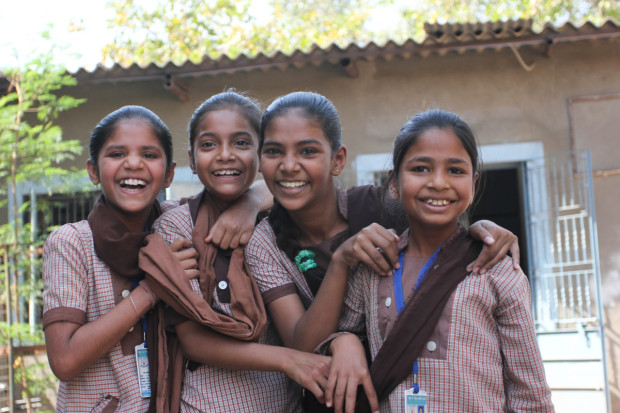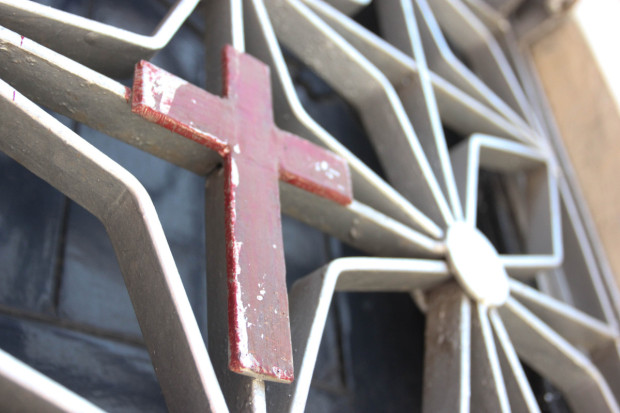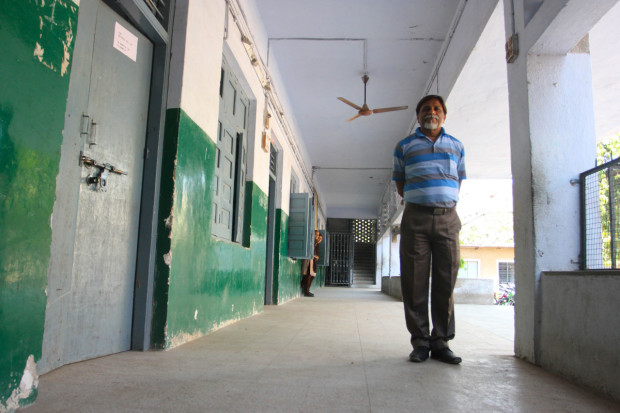AHMEDABAD — A woman in a hijab waits for her child in front of the Irish Presbyterian Mission School in this overwhelmingly Hindu Indian city. It’s 3:30 p.m. on a Saturday afternoon and the Muslim woman mingles comfortably with other parents, waiting for the Bible studies class to end.
In a city that is 80 percent Hindu, perhaps it is not surprising that Christians and Muslims have forged alliances in such matters as education. The I.P. Mission School, founded by Christians in 1866 to educate poor Hindus, is now 90 percent Muslim. The principal and most of the teachers, however, are Christian.
Many Muslim parents say that they are more comfortable with having their children in a Christian school than in state schools, according to the principal of the mission school. The state schools are run by the local state government, which since 1998 has been dominated by the Hindu nationalist BJP Party. The education of Muslim children has been challenging in India. Muslims students are less likely than others to carry on their education in India. Less than 80 percent of Muslim students who start their education in Grade I make it to Grade V, compared with 93 percent of the students nationwide in India, according to the District Information System for Education.

90 percent of the student population at I.P. Mission School are from Muslim families. Photo by Rachel Lowry.
Steve Ramey, associate professor at the University of Alabama, who specializes in the religions of Asia, said that when Christians say Muslims feel safer in their schools, it’s “partially the perception of a perception.” Teachers perceive that parents feel their children wouldn’t be safe in a Hindu school. It’s difficult to know to what extent this meta-perception is based on experience, rather than stereotypes of “the other,” that the parents have of Hindu schools. Perception or not, however, they can exacerbate real religious tensions, he said.
Many Christian educators say that the aim of their schools is not to convert, but to educate. The mother in the hijab and other Muslim parents at the mission school don’t seem bothered by the fact that their children study the Christian Bible and even attend Christian services in the school.
The Saturday Bible studies class is not mandatory; but on every weekday, each child at the Irish Presbyterian Mission School must take part in Christian worship. “Every morning we are praying, prayers, Christian prayers,” said Anil Christian, a Christian teacher at the school. “Muslims join in but we’re not praying Muslim prayers or Hindu prayers,” he said. Students celebrate Christmas and other Christian holidays, but no event is organized for the two official holidays in Islam, Eid Al-Fitr and Eid Al-Adha, a celebration to break the fast at the end of Ramadan.
The I.P.Mission School is one of many private Christian schools in Gujarat that have worship in the classroom. Private schools, when they are unaided by the government, charge a fee – up to a few hundred rupees a year. Christianity is not the only religion that is taught in private schools. According to the U.S. Department of State, children throughout India are enrolled part-time or full-time in about 30,000 madrassas (Muslim schools). And in 2009, minority religious organizations filed a petition against a Madhya Pradesh state law that makes it mandatory for students to recite Hindu religious prayers before lunch at government schools.
At the I.P. Mission School, not only do children take part in religious services; regular classes are also influenced by Christianity. Anil Christian, who teaches science at the school, said that he keeps Christianity in mind whenever he is in the classroom. In biology classes, for example, he will emphasize the role of God to explain how humans are shaped.

Students at the I.P. Mission School are required to take part in Christian worship weekly despite their dominantly Muslim background. Photo by Rachel Lowry.
The I.P. Mission opened its doors to 34 students in 1866. Originally at least, the school was established to proselytize, among other aims. Christian missionaries “pioneered” the task of giving more people access to education, especially to tribal people, said Mehul S. Christian, the director of the I.P. Mission School. It was founded so “the people who were accepting Jesus Christ and coming to the Church, were giving opportunity to study, in mission schools,” he said.
Some have criticized the role of religion in classrooms, on the grounds that it is a form of forced conversion to those too young to understand religious difference. Such controversies are not new. Under the rule of the BJP since 1995, many Gujarati schools were created to promote the agenda of Hindu nationalists. Policies in the Indian constitution, too, remain vague and subject to misinterpretations. Current legislation continues to wrestle with the blurred lines between religious in schools and religion taught in schools. “Biologically,” Christian said, “All miraculous creation by God and that we teach these little people that there is something, there is God.”
At the dawn of India’s Independence, India’s leaders failed to define the role religion would play in the new political landscape, wrote scholar Shreya Parikh in the essay “Policies and Politics of Teaching Religion in India,” published in the book “Policies and Politics of Teaching Religion,” by Theodor Hanf and Karim El Mufti. Consequentially, many religious issues are now out of the Indian government’s control, she wrote. Education policy remained subject to misinterpretation. While the Indian government doesn’t allow religious teaching in public schools, it allows private religious schools to exist. And these schools can be used to proselytize to young children.

Anil Christian teaches science at the I.P. Mission School. He said he uses the classroom to emphasize his Christian beliefs in relation to the course material. Photo by Rachel Lowry.
The blurred separation between church and state can pose questions, Ramsey said. He met people who grew up as Hindus and attended Catholic schools. “They talked about prayer, the mass, reading the Bible all the time,” he said. “There is a certain amount of indoctrination that is a part of the curriculum, in a lot of the religious schools, whether they are Catholic, or Protestant, or Muslim, or Hindu.”
However, studying in a religious school that counters one’s beliefs doesn’t mean conversion, said Ramey. “In the United States we sometimes have an image of an evangelical going out and telling people they’re going to Hell if they don’t convert today.” India is more pluralistic, he said. Many don’t see a problem with “participating in a ritual of another religion,” Ramey said. In addition, he said, an individual can identify with different communities that are not exclusive. “Sometimes, your loyalty may be with your friends, sometimes your loyalty may be with your community – your religious community.”
Still, religious tensions do exist. In Gujarat, memories of the 2002 riots, which opposed Muslims and Hindus, remain vivid: more than a thousand people were killed. One person who works at the I.P Mission said that parents of Muslim kids preferred having their children in a Christian school rather than in a Hindu school.
Behind a rusty, aluminum gate that usually swings open with a slow creak, children giggle and skip in a shaded courtyard. The sandy tile of the schoolhouse seems to extend to the identical church a few feet away, both hallowed spaces for education and religion. Sometimes it’s hard to tell which.